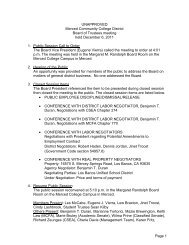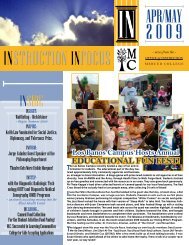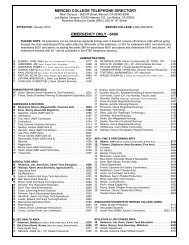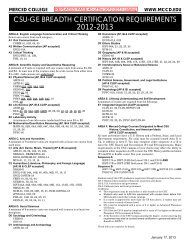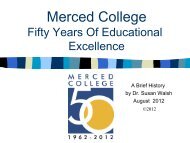Student Handbook 2013 - Merced College
Student Handbook 2013 - Merced College
Student Handbook 2013 - Merced College
Create successful ePaper yourself
Turn your PDF publications into a flip-book with our unique Google optimized e-Paper software.
E. Objectives<br />
The Diagnostic Medical Sonography Program faculty believe that the philosophy of the<br />
program can be fulfilled through providing a curriculum that encompasses all the areas<br />
required to prepare students to practice in the professional discipline. Since sonography<br />
is a practice discipline, the objectives will reflect what areas a graduate sonographer will<br />
be competent. The objectives reflect those areas included in the curriculum content as<br />
stated in the Standards and Guidelines for Diagnostic Medical Sonography from the<br />
Commission on Accreditation of Allied Health Education Programs (CAAHEP) in<br />
conjunction with the Joint Review Committee on Education in Diagnostic Medical<br />
Sonography (JRCDMS). At the completion of the Program, the student will be prepared<br />
to practice in the professional discipline because, at a minimum, they are competent in<br />
the following areas:<br />
1. Oral and written communication<br />
2. Provide basic patient care and comfort<br />
3. Demonstrate knowledge and understanding of human gross anatomy and<br />
sectional anatomy<br />
4. Demonstrate knowledge and understanding of physiology, pathology, and<br />
pathophysiology<br />
5. Demonstrate knowledge and understanding of acoustic physics, Doppler<br />
ultrasound principles, and ultrasound instrumentation<br />
6. Demonstrate knowledge and understanding of the interaction between<br />
ultrasound and tissue and the probability of biological effects in clinical<br />
examinations including:<br />
a. Biologic effects<br />
b. Pertinent in-vitro and in-vivo studies<br />
c. Exposure display indices<br />
d. Generally accepted maximum safe exposure levels<br />
e. ALARA principle<br />
7. Employ professional judgment and discretion<br />
8. Understand the fundamental elements for implementing a quality assurance and<br />
Improvement program, and the policies, procedures for the general function of<br />
the ultrasound laboratory, including<br />
a. Administrative procedures<br />
b. Quality control procedures<br />
c. Elements of quality assurance program<br />
d. Records maintenance<br />
e. Personnel and fiscal management<br />
f. Trends in health care systems<br />
9. Recognize the importance of continuing education<br />
10. Recognize the importance of, and employ, ergonomically correct scanning<br />
Techniques<br />
11. Demonstrate the ability to perform sonographic examinations of the abdomen,<br />
superficial structures, non-cardiac chest, and the gravid and nongravid pelvis<br />
according to protocol guidelines established by national professional<br />
organizations and the protocol of the employing institution utilizing real-time<br />
equipment with both transabdominal and endocavitary transducers, and Doppler<br />
display modes.<br />
5



